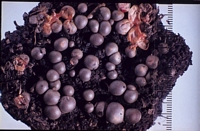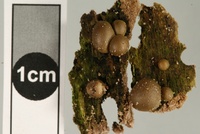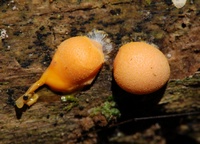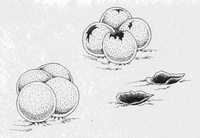|
 Lycogala epidendrum Lycogala epidendrum
SynonymsLycogala miniatum
Lycoperdon epidendrum
BiostatusPresent in region - Indigenous. Non endemic
Images (click to enlarge)
Owner: Herb. PDD | 
Owner: J.A. Cooper | 
Owner: J.A. Cooper | 
Caption: Aethalia of Lycogala epidendrum, which often occur in small groups as shown here. Each individual aethalium is approximately 1.0 cm broad
Owner: S.L. Stephenson | |
Article: Cooke, M.C. (1879). New Zealand fungi. Grevillea 8(46): 54-68.
Article: Stephenson, S.L. (2003). Myxomycetes of New Zealand. Fungi of New Zealand. Ngā Harore o Aotearoa 3: xiv + 238 p. Hong Kong: Fungal Diversity Press.
Description: Fruiting body an aethalium, usually several to many in a single fruiting, these scattered to crowded, subglobose to depressed-spherical or irregular from pressure, pinkish grey or yellowish brown to deep olivaceous or nearly black, 0.3–1.5 cm broad. Cortex warted or merely roughened, rather thin and fragile, especially above. Pseudocapillitium composed of long, branching and anastomosing flattened tubules marked with conspicuous transverse folds and wrinkles. Spores at first pink or grey in mass, changing to pale ochraceous or pallid, colourless by transmitted light, reticulate, 6–8 µm in diameter. Plasmodium pink to coral red or orange to cream coloured.
Habitat: Decaying wood and (less commonly) bark.
Distribution: Cosmopolitan (Martin & Alexopoulos 1969). First reported from New Zealand by Cooke (1879), based on a specimen collected in Wellington. Also known from Northland, Auckland, Coromandel, Bay of Plenty, Taupo, Wanganui, Hawkes Bay (Colenso 1887), Nelson, Buller, Westland, Fiordland, Mid Canterbury, South-land, and Stewart Island (Lister & Lister 1905) but undoubtedly present elsewhere.
Notes: This is one of the most widely distributed and best-known myxomycetes. Lycogala epidendrum is rather variable both morphologically and in the colour of the plasmodium, and some authors (e.g., Nannenga-Bremekamp 1996, Ing 1999) have separated out several of the more consistently occurring forms as varieties or even distinct species. In such cases, the concept of Lycogala epidendrum is restricted to those forms characterized by a pure red or carmine plasmodium and a spore mass that is grey when fresh, while forms with a plasmodium that is orange or pink to cream and spores that are pink when fresh are recognized as L. terrestre. However, the distinction between the two forms has not been made in most previous studies. It appears that both occur in New Zealand
|